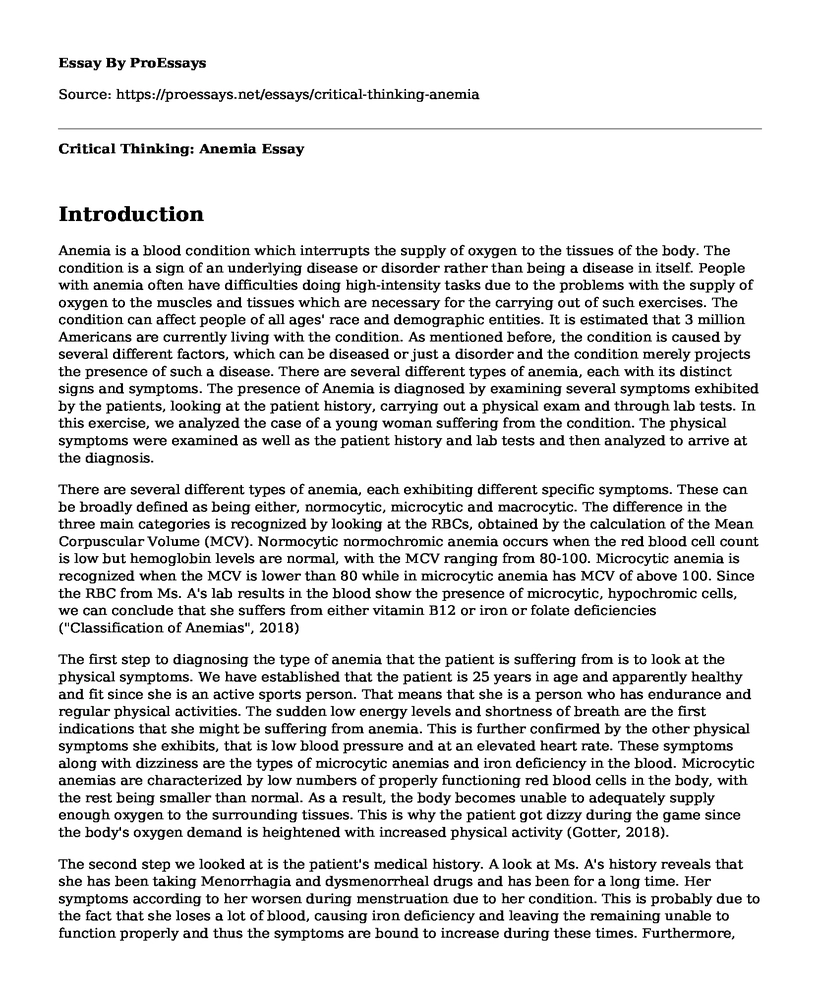Introduction
Anemia is a blood condition which interrupts the supply of oxygen to the tissues of the body. The condition is a sign of an underlying disease or disorder rather than being a disease in itself. People with anemia often have difficulties doing high-intensity tasks due to the problems with the supply of oxygen to the muscles and tissues which are necessary for the carrying out of such exercises. The condition can affect people of all ages' race and demographic entities. It is estimated that 3 million Americans are currently living with the condition. As mentioned before, the condition is caused by several different factors, which can be diseased or just a disorder and the condition merely projects the presence of such a disease. There are several different types of anemia, each with its distinct signs and symptoms. The presence of Anemia is diagnosed by examining several symptoms exhibited by the patients, looking at the patient history, carrying out a physical exam and through lab tests. In this exercise, we analyzed the case of a young woman suffering from the condition. The physical symptoms were examined as well as the patient history and lab tests and then analyzed to arrive at the diagnosis.
There are several different types of anemia, each exhibiting different specific symptoms. These can be broadly defined as being either, normocytic, microcytic and macrocytic. The difference in the three main categories is recognized by looking at the RBCs, obtained by the calculation of the Mean Corpuscular Volume (MCV). Normocytic normochromic anemia occurs when the red blood cell count is low but hemoglobin levels are normal, with the MCV ranging from 80-100. Microcytic anemia is recognized when the MCV is lower than 80 while in microcytic anemia has MCV of above 100. Since the RBC from Ms. A's lab results in the blood show the presence of microcytic, hypochromic cells, we can conclude that she suffers from either vitamin B12 or iron or folate deficiencies ("Classification of Anemias", 2018)
The first step to diagnosing the type of anemia that the patient is suffering from is to look at the physical symptoms. We have established that the patient is 25 years in age and apparently healthy and fit since she is an active sports person. That means that she is a person who has endurance and regular physical activities. The sudden low energy levels and shortness of breath are the first indications that she might be suffering from anemia. This is further confirmed by the other physical symptoms she exhibits, that is low blood pressure and at an elevated heart rate. These symptoms along with dizziness are the types of microcytic anemias and iron deficiency in the blood. Microcytic anemias are characterized by low numbers of properly functioning red blood cells in the body, with the rest being smaller than normal. As a result, the body becomes unable to adequately supply enough oxygen to the surrounding tissues. This is why the patient got dizzy during the game since the body's oxygen demand is heightened with increased physical activity (Gotter, 2018).
The second step we looked at is the patient's medical history. A look at Ms. A's history reveals that she has been taking Menorrhagia and dysmenorrheal drugs and has been for a long time. Her symptoms according to her worsen during menstruation due to her condition. This is probably due to the fact that she loses a lot of blood, causing iron deficiency and leaving the remaining unable to function properly and thus the symptoms are bound to increase during these times. Furthermore, her underlying condition might be the main cause of her Anaemia and if not, then it no doubt contributes to its severity.
Since we have the leads as to what Mrs. A might be suffering from, we need to look at the results of the screening tests to ascertain exactly what type it is. Her Hemoglobin level of 8g/dl is lower than the 11.5 normal in a healthy female. Her Hematocrit count of 32% is also slightly lower than the normal minimum of 36% in healthy females. The implication of these results is that her MCV is low. Given that her reticulocyte count falls at the normal 0.5-1.5% at 1.5% her bone marrow must be functioning well. The cause of the low MCV must, therefore, be the iron deficiency ("Laboratory Evaluation of Anemia", 2018).
Conclusion
Looking at the information we have analyzed above, we, therefore, conclude that Ms. A must be suffering from iron deficiency anemia. Also looking at her medical history we know that she has Menorrhagia and dysmenorrheal, which is a condition that results in a higher than normal menstrual flow in women, and which results in a higher than normal blood loss during menstruation. Given that she has been suffering from the condition for a long period of time, we can conclude that it is the cause of her anemia.
References
Classification of Anemias. (2018). Retrieved from http://www.klinikaikozpont.u-szeged.hu/pedia/images/pdf/CME_AN/7ANCL.pdf
Laboratory Evaluation of Anemia. (2018). Retrieved from http://pitt.edu/~mazst19/leoa.html
Gotter, A. (2018). Everything You Need to Know About Microcytic Anemia. Retrieved from https://www.healthline.com/health/microcytic-anemia
Cite this page
Critical Thinking: Anemia. (2022, Mar 11). Retrieved from https://proessays.net/essays/critical-thinking-anemia
If you are the original author of this essay and no longer wish to have it published on the ProEssays website, please click below to request its removal:
- Aging Parents Essay Example
- Standards 3 and 4 of Naeyc Learning Methodologies Paper Example
- Essay Sample on Trauma Impact
- Vaccination for Pregnant Women
- Essay on Teaching With Passion: The Lightbulb Moment that Fuels My Fire
- Essay on Immigration Rates and Early Child Education: A Look at the Effects
- Cognitive Ability: 100% Innate or Learned? - Free Essay Example







